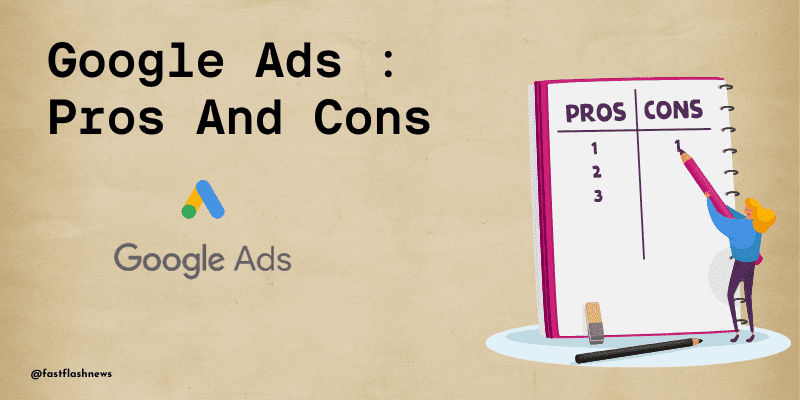Google Ads: What Are They?
Google Ads is the company’s paid advertising (PPC) offering. They are easily identified by the small advertisements that appear at the top and bottom of search results. Whether you click on them or not, or whether you like them or not, the truth is that they have the potential to be very effective in driving customers to your website. When someone enters a search query onto Google, advertisements show up. The business will bid on terms associated with their specific industry. Google enters hundreds of keywords and adverts into a “auction” in a split second to determine which are most relevant to the search query. Next, “winning ads” appear at the top of the list.
What advantages do Google Ads offer?
If you want to rapidly increase visitors to your website, Google AdWords might be quite beneficial. Google Ads generates results almost instantaneously, but SEO might take weeks or even months to show results.
It’s time efficient
It won’t take long for you to get started with Google Ads. These are the basic building blocks of Google Ads, and they can be set up pretty fast, even though there is much more to the platform than just campaigns, ad groups, keywords, and ads. Set up a campaign and a few ad groups, conduct some keyword research, choose your budget, write some amazing ad text, and get started. As soon as your ads are approved—which might happen instantly—they will start to show.
Reach the appropriate group of people
It is more probable that customers will choose to purchase from you over your rivals if you are positioned farther up the search results page. This is because greater exposure to people who are actively looking for the things you offer will increase.
You may now stand out to potential clients even more because in 2016 text advertising got bigger and occupied more space in the search results. With choices to include site links and structured snippet extensions, the advertisements have also grown more interesting. Because of all these qualities, your adverts will typically look more appealing and compelling than your natural listings.
Learn more about your customers
With Google AdWords, you can test which landing pages and keywords bring in the most traffic. You can also discover a lot about your target audience’s search habits.
In a very short period of time, you will be collecting a massive amount of data. This is the greatest way to find out what occurs when you drive a lot of traffic to your website.
Your budget can be any size
The cost of Google Ads doesn’t have to be high. If you’re a personal injury attorney, you may have to pay between £50 and £60 per click, but if you’re not, small businesses can easily set up and benefit from tiny, highly optimized campaigns. You only pay for clicks after deciding how much you’re ready to spend and establishing your maximum cost per click for your keywords. This lets you continue to be in charge of your spending.
Additionally, you are in total control of the timing of your advertisements. Run
your campaign to attract visitors, then switch off your adverts to save money once you have received enough inquiries.
What are the issues with Google Ads?
You have to pay per click
This implies that you are charged every time a user clicks on your advertisement, whether or not the click results in a conversion. As a result, you can receive clicks from website visitors who never plan to purchase your good or service and never pay for it. This can be the case if you haven’t incorporated enough negative keywords to your campaigns; in that case, you won’t see many conversions because the wrong users will see your advertising.
Competitive industries have a higher CPC
It might be a smart idea to launch your own campaign if your rivals are already using Google Ads; nevertheless, intense competition frequently results in higher cost per click. Put simply, a high number of bids for the same item (in this example, keywords) indicates that the price will grow steadily, just like in an auction. Your ads may be pushed to pages two or three of the search results if your keyword bid is too low.
It’s a short-term investment
Google advertising have a very short lifespan; your advertising stop running as soon as your budget is depleted. Although it could be alluring to see results right away, it’s a good idea to weigh your options. While effects from SEO (search engine optimization) may take up to a year to show up, they will stay far longer than your money. SEO will raise your site’s organic rating.
Ads have limitations
There are three thirty-character headlines, two lengthy ninety-character explanation lines, and a customizable display URL. The amount of characters you can use is limited. This is not a lot of room for a call to action, perks, keywords, and an attention-grabbing headline—all of which are essential to getting clicks.
You must schedule time for investment
Google AdWords has a learning curve that is fairly steep. After the campaign has been set up, you will need to dedicate a significant amount of time to making sure it is performing as planned. You will also need to dedicate time on a regular basis to tracking which conversions are occurring and which are not.
Landing pages need to be seamless
Google also evaluates the quality of your landing pages, therefore the relevancy of your website to the search query must be excellent. In the end, you can’t solely rely on Google Ads to drive traffic—you also can’t ignore SEO in favor of ads; your landing pages must be high-quality and pertinent to your ads. Your Quality Score will rise with better landing pages for your website, which will result in lower click-through rates.
Customer life cycle
You might not get the return on investment you were hoping for if the customers of your items have to consider, save, and investigate them. Google AdWords can only assist you in expanding your consumer base if you’re a patient player.




